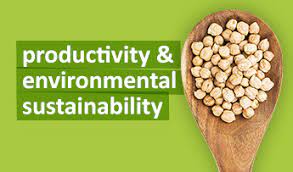Free Courses Sale ends Soon, Get It Now


Free Courses Sale ends Soon, Get It Now



Disclaimer: Copyright infringement not intended.
Introduction
Concerns about Agriculture
Sustainability
Pesticides
Antibiotics
Loss of Biodiversity
|
Summary of Main Challenges for Food and Agriculture |
||||
|
Structural challenge |
Productivity challenge |
Sustainability challenge |
Climate change challenges and opportunities |
|
|
Argentina |
Investment in rural and transport infrastructure |
Regional and product differences in productivity growth |
Deforestation, increased use of inputs affecting water and air quality |
Increasing frequency of extreme weather events, melting of glaciers |
|
Australia |
Increasing differences between small and large farms. Remoteness of some farms |
Availability of new technology. Drought and water shortages constrain productivity growth |
Water and soil constraints, Greenhouse Gas (GHG) emissions |
More severe water constraints |
|
Brazil |
Dualistic structure |
Large productivity gap between subsistence and commercial farms |
Land management, GHG emissions |
Not included in the review |
|
Canada |
Production quotas, weak food industry, and small domestic market |
Mainly in the dairy sector |
Land management affecting biodiversity, regional water quality issues from excess nutrients |
Better growing conditions in some regions, increased frequency of extreme weather events (floods, droughts), potential increase in pest and disease |
|
China |
Small farms dominate. Income gap between rural and urban households |
Water resource constraints, small farms |
Water resources constraints, pollution of soils and water, and expansion of intensive livestock production |
Rising temperatures, more frequent extreme weather events, spread of pests and disease |
|
Colombia |
Small, subsistence farms |
Large differences by commodity sector. Low productivity in dairy farms due to small scale, high input prices, poor transport infrastructure and inefficient value chain |
Land management affecting biodiversity, GHG emissions, and intensive use of inputs |
Rising and more erratic precipitations causing soil degradation. Rising temperatures requiring moving production in higher altitudes (Coffee). Melting of glaciers and disappearance of moorland |
|
Estonia |
Dualistic structure |
Productivity driven by a small number of larger farms, high growth rates reflecting catch up |
Local water pollution by nutrients |
Better growing conditions despite potential increase in pests and diseases, and rainfall variability |
|
Japan |
Increasing differences between small and large farms |
Labour shortages and ageing |
High nutrient surplus driven by intensive use of fertiliser, GHG emissions. |
Increased frequency of extreme weather events (typhoons) |
|
Korea |
Small farms dominate. Income gap between rural and urban households |
Productivity gap with manufacturing sector, small farms |
High nutrient surplus. Expansion of intensive livestock production, increasing nutrient surplus and GHG emissions |
More typhoons; more erratic monsoons; warming in the South |
|
Latvia |
Dualistic structure |
Productivity driven by a small number of larger farms, high growth rates reflecting catch up |
Local water pollution by nutrients |
Better growing conditions, increase in pest and disease, and rainfall variability |
|
Netherlands |
High land prices |
Sustain growth with higher constraints |
Water pollution by nutrients, GHG emissions and biodiversity |
Increased frequency of extreme weather events, Water management |
|
Sweden |
Areas with natural handicaps (northern latitudes) |
Low and declining growth rate for some sectors |
Eutrophication, biodiversity and GHG emissions |
Better growing conditions, prolonged cultivation period, climate favourable to other crops |
|
Switzerland |
Areas with natural handicaps (mountains) |
Low and declining growth rate |
Nitrogen surplus does not meet country targets |
-- |
|
Turkey |
Large number of small farms |
Productivity gap between small and larger farms |
Water scarcity, water quality and soil erosion |
Increased water stress and temperature increase affecting agriculture |
|
United States |
Labour shortage |
Declining growth rate |
Water scarcity, pollution and soil erosion particularly in certain regions |
Higher frequency of extreme weather events, higher water constraints in some regions |
The case of India
Way Ahead: Climate-resilient Agriculture
Strategies and technologies for climate change adaptation
Gene Editing
Tolerant crops
Water management
Agro-advisory
Soil organic carbon
National Programmes for climate change adaptation
Role Models
Way ahead
https://www.mdpi.com/2073-4395/8/7/116/htm
© 2024 iasgyan. All right reserved